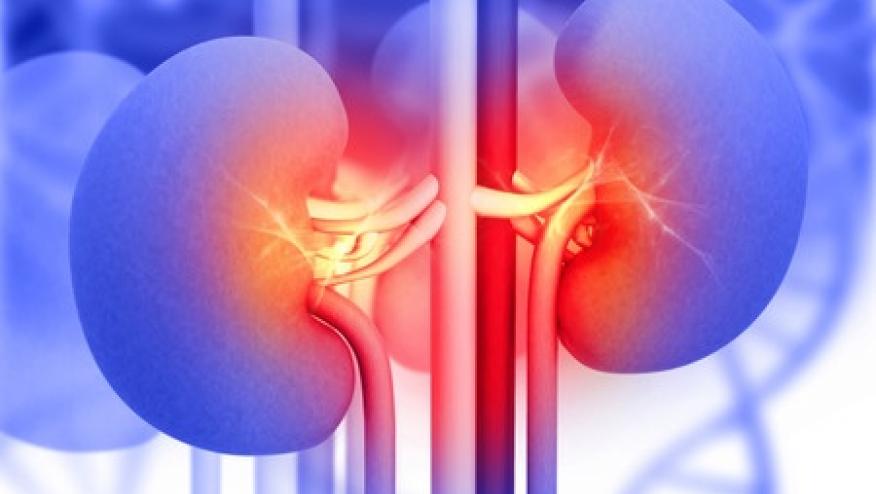Renal Function Safe With Pegloticase-MTX Combo for Gout Save

For patients with uncontrolled gout, estimated glomerular filtration rate (eGFR) remained stable with combination pegloticase (Krystexxa) and methotrexate treatment, researchers reported.
Looking more closely at the 12-month findings from the MIRROR trialopens in a new tab or window published last September, clinicians can now be reassured that renal function wasn't negatively impacted in patients with up to stage 3 chronic kidney disease (CKD).
CKD stage remained stable or improved in 93.1% of patients on pegloticase/methotrexate, while the same was true for 93.8% of those on pegloticase plus placebo, reported Abdul Abdellatif, MD, of Baylor College of Medicine in Houston, during the National Kidney Foundation Spring Clinical Meeting.
All patients with stage 1 CKD remained stable, but about 10% of those with stage 3 improved to stage 2 CKD while on the co-therapy:
- Stage 1 CKD: 10.3% of patients at baseline versus 10.3% at week 52
- Stage 2 CKD: 46.6% versus 55.2%, respectively
- Stage 3 CKD: 43.1% versus 34.5%, respectively
By week 52, no patients with an eGFR below 60 (stage 3) saw worsening of renal function. Most (68%) saw stability, and about a third saw improvement.
"We know that CKD is a huge risk factor for developing gout," co-author Brad Marder, MD, medical director at Horizon Therapeutics, told MedPage Today. "The kidneys basically have to excrete the burden of uric acid that's produced by the body. If the kidneys aren't working well, the kidneys are going to excrete less of it and when you retain more uric acid, it's going to crystallize and cause more gout."
A lot of these patients with uncontrolled gout have "pretty bad kidney function," he pointed out.
"When you look at patients with stage 3 CKD, a quarter of them have gout. When you look at patients with stage 4 CKD, a third of them have gout," he said. "It's important, especially for nephrologists, to appreciate how common gout is in their patients."
"Gout is not just an annoying, painful disease -- it's a systemic disease that's progressive and it's a lot worse for you than you think," Marder underscored. "Patients with gout have higher mortality rates, higher risk of cardiovascular disease, and worse progression of CKD."
The FDA initially approved pegloticase in 2010 for chronic uncontrolled gout. In July 2022, the FDA gave the greenlight to a label expansion that included co-administration with methotrexate based on the MIRROR trial findings. In MIRROR, 71.0% of those on the co-therapy met the primary endpoint of serum urate below 6 mg/dL after 6 months compared with 38.5% of those receiving placebo plus pegloticase.
There were also far fewer side effects when methotrexate was added to the mix, with only 4.2% experiencing an infusion reaction versus 30.6% in the placebo-pegloticase group.
In this eGFR-focused analysis of the trial, the researchers honed in on 100 patients who received the combination therapy compared with 52 patients on pegloticase plus placebo. The average age of those on combination therapy was 56, 91% were men, and mean BMI was 32.7; 21% had a history of kidney stones.
In the combination group, eGFR was 69.8 mL/min/1.73 m2 by week 52 (mean change from baseline +4.6) and 69.7 mL/min/1.73 m2 in the placebo group (mean change from baseline +1.7).
Patients with an eGFR below 40 were excluded -- a limitation of the trial, said Marder.
"Despite the fact that none of the patients had GFR's less than 40, a third of the patients had GFR's less than 60 -- so there is a good cohort of patients with stage 3a or 3b CKD. But nobody with worse kidney function than 40 mL/min/1.73 m2," he noted.
"There are other options for patients who want to use pegloticase but can't take methotrexate for some reason," he added.
"There are prescribers, there are doctors -- rheumatologists, nephrologists -- that are willing to prescribe methotrexate, maybe at a lower dose for patients who have GFR's less than 40. But still, there are other options for those patients," he explained. "It's not in our drug label like methotrexate is, but using a drug like mycophenolate mofetilopens in a new tab or window is a good option for patients who have kidney function less than 40 mL/min/1.73 m2, as is leflunomideopens in a new tab or window or azathioprine."
The recommended dosage of pegloticase is 8 mg every 2 weeks given as an intravenous infusion, co-administered with weekly methotrexate 15 mg orally, according to the updated labelopens in a new tab or window.
"For even the worst gout cases, there are effective medications to help lower the uric acid so that these crystals can dissolve and you can get them out of your body," Marder concluded.









If you are a health practitioner, you may Login/Register to comment.
Due to the nature of these comment forums, only health practitioners are allowed to comment at this time.